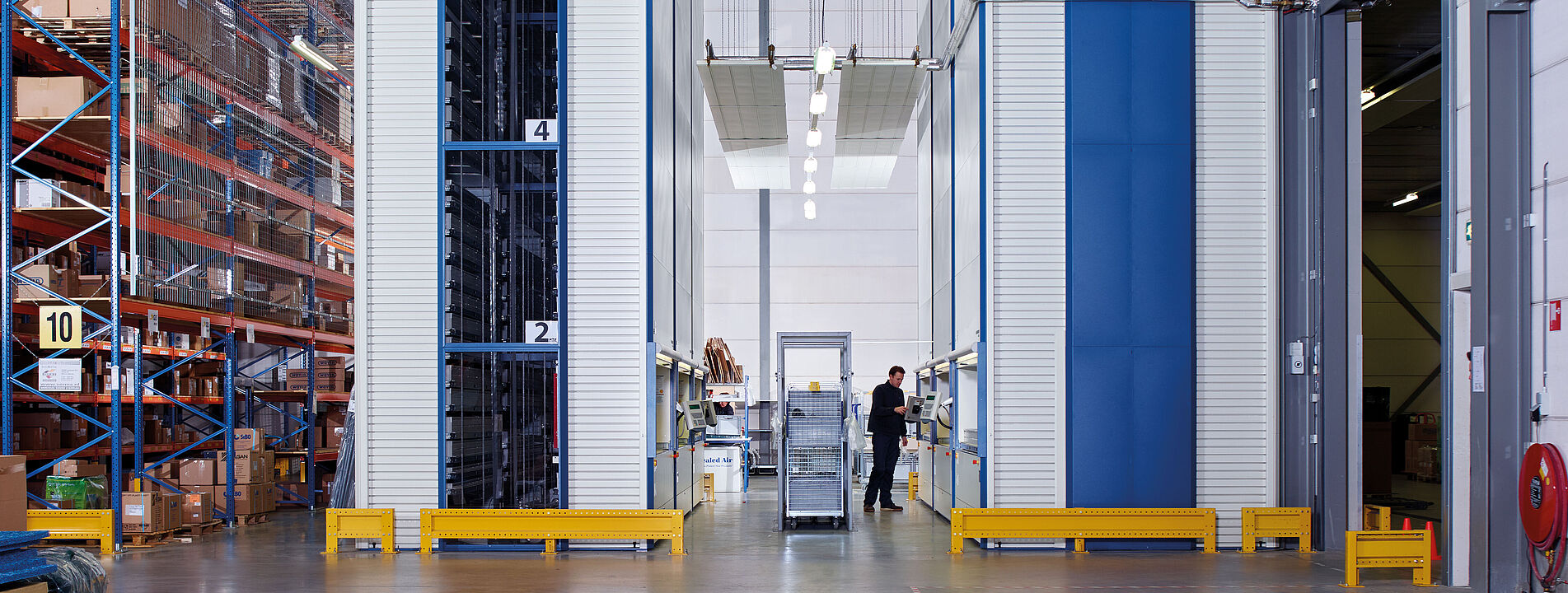Warehouse System
Safety, efficiency, precise inventory control
The warehouse system plays an important role in the supply chain and inventory management of a business enterprise, whether is is part of a distribution center, e-commerce order fulfillment facility or other type of application. It represents a conglomeration of various types of storage, such as racks, shelves, bins, boxes or on-floor storage. The purpose of warehouse management is to provide for the optimal internal flow of material and information, so a business can be a viable component of the supply chain. Warehouse management involves the identification, inspection and controlled storage of goods received – all items in stock are precisely managed and then picked for customer orders to be shipped on demand. This internal system also has an impact on warehouse management, the use of material handling equipment and conveyors, as well as the management of personnel.
Warehousing goes hand in hand with both supply chain management and inventory management. Supply chain activities cover the active movement and storage of goods and materials, as well as the flow of information that coordinates planning, while an inventory management system tracks raw materials and finished product to keep them at the right levels at all times.
There are two types of warehouse systems for inventory management – dynamic or static. Dynamic storage means that items are consistently picked for order fulfillment, while static storage means that overflow product is stored in reserve, most often on pallets. When items from the dynamic area have been picked, new supplies are pulled from from the static area to replenish them. The configuration of warehouse management can determine overall productivity and efficiency.
The techniques used for warehouse operations can be manual or automated. With a manual design, or "man to goods," workers move to a pick location, pick a needed item, then move it to shipping dock. On the other hand, automated warehousing employs extensive conveyors, sorters, automated storage and retrieval systems (ASRS) and other material handling equipment that move "goods to man" with very little movement needed from workers. There are many kinds of storage solutions available to meet the wide range of warehousing requirements in different kinds of applications. Typical solutions include miniload systems for small items, pallet racks, buffer storage, parts storage, high-bay warehouse solutions, vertical storage and heavy-duty storage.
Automated storage solutions are controlled by a warehouse management software, or WMS, commanding motors to drive the automated rack and shelf storage systems and automatically dictating which inventory items to put and pick from storage and retrieval machines (SRM). Thanks to the use of these inventory management storage systems, manual warehouse tasks are greatly reduced, and business enterprises save considerable time and space while also boosting productivity. WMS software often integrates with a business' existing ERP software, to provide a complete overview of its inventory.
Advantages of storage systems
- A warehouse management system offers several advantages for businesses across the supply chain, from distribution centers to e-commerce:
- Short routing and fast transport times for put and pick operations (little or no walking)
- High throughput performance due to faster and more efficient supply chain processes
- Good delivery quality and flexibility stemming from safe and secure transport
- Minimized risk of picking errors, plus constantly optimized stock quantities
- Real-time, continuous monitoring and inventory updates to ensure optimal warehouse storage capacity
- Seamless integration with a customer's existing ERP system
In addition to the advantages of a conventional storage system, the industry-leading Hänel Lean-Lift® offers height-optimized storage. This feature enables users to store items of varying size, and the machine will always find the most appropriate storage location. Its design reduces the floor space previously required for storage by up to 60%, which cannot be done with containers on simple storage rack. Thanks to innovative technology, the Hänel Lean-Lift® provides high-density storage capacity within the smallest footprint possible, and allows users to maintain proper inventory levels, which reduces warehouse costs. Customized solutions and special options available for the Hänel storage system make warehousing even more efficient and allow the warehouse management system to precisely address the needs of the business enterprise.


